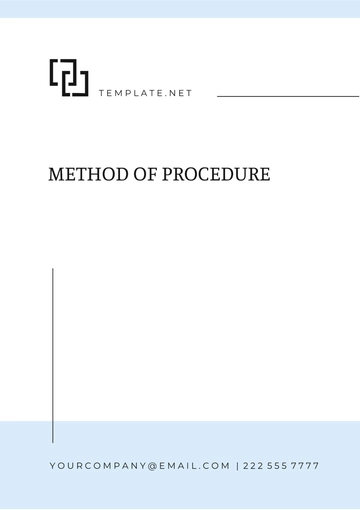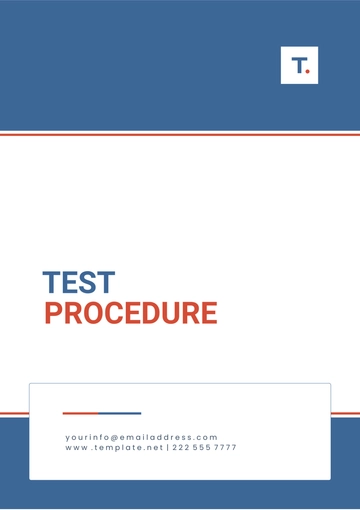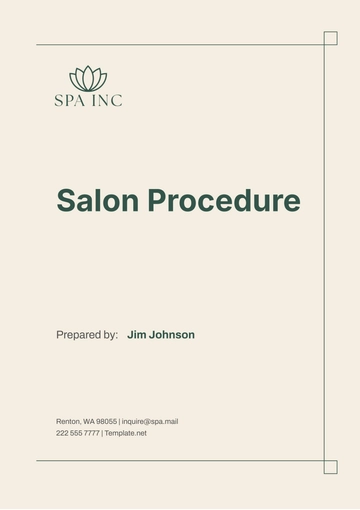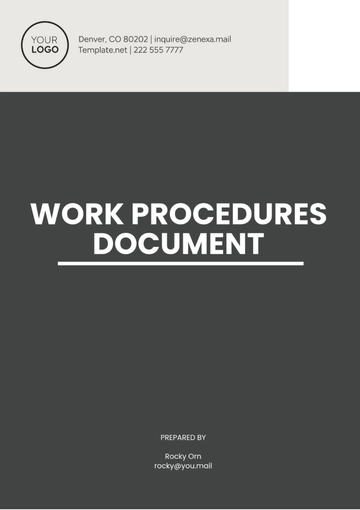Free Kindergarten Safety Procedure

1. Introduction
At [Your Company Name], the safety and security of children are paramount. With the growing awareness of potential risks in early childhood education, it is essential to create an environment where parents, children, and educators can trust that every precaution has been taken to safeguard young learners. This Kindergarten Safety Procedure outlines comprehensive protocols, procedures, and policies that address all aspects of safety within our kindergarten facilities.
In our pursuit of excellence, we continually reassess our safety measures to meet the highest standards, embracing new technologies and strategies to ensure a safe environment for children. These procedures have been established in line with the latest global safety regulations, research, and best practices, effective from the year 2050. We are committed to making safety an ongoing priority, with regular reviews and updates to these protocols to stay current with evolving challenges and innovations. This document serves as a detailed guide for staff, parents, and visitors to understand and follow the safety standards set by [Your Company Name].
2. General Safety Policies
2.1 Importance of Safety
The kindergarten setting is a space where young minds are nurtured, but it is also a place that can present numerous safety hazards if proper measures are not in place. The importance of maintaining high safety standards cannot be overstated, as it directly impacts not only the physical health of children but their emotional and psychological well-being as well. A secure environment fosters a sense of comfort and trust, allowing children to thrive and engage more fully in educational activities.
Safety at [Your Company Name] is integral to our educational philosophy. It is woven into every aspect of our operations, from the design of our facilities to the training of our staff. We understand that parents entrust their children to us every day, and part of that trust is the assurance that we are doing everything possible to keep them safe from harm. By emphasizing safety, we are able to focus on the child's development, knowing that they are protected from accidents, health risks, or abuse. This, in turn, strengthens the bond between children, parents, and the kindergarten, creating a supportive, community-driven environment.
2.2 Safety Vision Statement
[Your Company Name] is committed to creating a safe, nurturing environment that protects the well-being of every child in our care. Our vision is to ensure that all safety measures, policies, and procedures are upheld rigorously so that children can focus on learning, growing, and discovering the world around them without fear of harm. We envision a future where our safety standards are the benchmark for early childhood education, where every child, parent, and educator can feel secure, valued, and confident in the safety measures we implement.
By 2050, we aim to incorporate cutting-edge technology and advanced safety strategies that address the ever-changing landscape of child safety. We will continue to adapt to emerging trends and challenges while maintaining our commitment to creating a safe, inclusive, and inspiring educational space.
3. Building Safety Standards
3.1 Entry and Exit Protocols
The entry and exit points of our facilities are the first line of defense in maintaining a secure environment. At [Your Company Name], we have implemented strict access control measures that regulate who can enter or exit the premises at any given time. All authorized personnel are required to authenticate their identity via biometric systems, such as fingerprint or facial recognition scanners. This ensures that only approved staff and parents can gain access to the building, reducing the risk of unauthorized individuals entering.
For visitors, a digital registration system is in place, where they must sign in using a dedicated kiosk and receive an identification badge that must be worn throughout their stay. This system helps monitor who is in the building and ensures that all visitors are accounted for in the event of an emergency.
In terms of evacuation, emergency exits are clearly marked and easily accessible. Smart exit systems are in place to alert staff if any doors are opened during non-emergency situations. These measures help prevent unauthorized access while also ensuring that everyone can exit quickly and safely during an emergency.
Protocol | Description | Timeline for Compliance |
|---|---|---|
Biometric Scanner Installation | Facial recognition for parents and staff | 2050 |
Visitor Registration System | AI-enabled, cloud-based log maintenance | 2051 |
3.2 Classroom Layout Requirements
A key component of our safety measures is the design of our classrooms. At [Your Company Name], we believe that a safe classroom is one that minimizes the risk of injury while fostering an engaging learning environment. To achieve this, all classroom furniture is designed with child safety in mind. Rounded edges and non-toxic materials are used to reduce the risk of accidents.
Each classroom is designed to provide ample space for movement, ensuring that children do not feel cramped or overcrowded. This is essential, as it reduces the likelihood of accidental falls or other injuries. A minimum of [20 square feet] per child is maintained to allow for freedom of movement and easy access to educational materials.
In addition, each classroom has a designated "safe corner" where children can gather in the event of an emergency. This area is equipped with soft mats and calming elements to provide comfort during stressful situations.
3.3 Maintenance Schedule
Ensuring the ongoing safety of our facilities requires regular maintenance. At [Your Company Name], we follow a detailed maintenance schedule to ensure that all systems and equipment remain in optimal condition. This includes daily checks of sanitation and cleaning procedures, monthly inspections of electrical systems and plumbing, and annual reviews of major structural elements like HVAC systems and building integrity.
By performing routine checks, we ensure that potential hazards are identified and addressed before they pose a risk to children. For example, any faulty equipment is immediately repaired or replaced to prevent accidents. In addition to physical maintenance, we also conduct regular safety audits to assess the effectiveness of our procedures and make necessary improvements.
4. Emergency Procedures
4.1 Fire Evacuation Plan
Fire safety is a critical aspect of our emergency preparedness plan. At [Your Company Name], we have invested in a state-of-the-art fire alarm system that not only detects smoke or fire but also sends real-time alerts to staff and parents through their mobile phones. This ensures that everyone is aware of the situation and can respond quickly.
Each classroom has clearly marked evacuation routes that lead children to safe assembly points outdoors. These routes are wide and free from obstacles, ensuring that children and staff can exit the building swiftly in case of an emergency. The safe zones outdoors are located in secure areas, away from the building to reduce the risk of injury during a fire.
Fire drills are conducted regularly, at least [4] times a year, to ensure that all staff and children are familiar with the procedures. These drills are closely monitored, and feedback is gathered to make improvements to the evacuation process if necessary.
Frequency | Activity | Notes |
|---|---|---|
Quarterly | Fire Drill | Ensure participation of 100% staff and students |
4.2 Earthquake Drills
In addition to fire safety, earthquake preparedness is a major component of our emergency procedures. Earthquakes can strike without warning, which is why it is essential that every child and staff member knows how to respond. At [Your Company Name], we have implemented a seismic safety plan that includes clear instructions on how to protect oneself during an earthquake.
Classrooms are designed to withstand seismic activity, with reinforced structures capable of handling earthquakes of up to [magnitude 9.0]. Each classroom has designated "Duck, Cover, and Hold" zones, where children can take shelter under desks or tables during a tremor.
Regular earthquake drills are conducted to ensure that children and staff are prepared for such an event. These drills include simulations where children practice getting under desks and holding onto their shelters until the shaking stops. Children are also taught how to protect their heads and necks during an earthquake, further ensuring their safety.
4.3 Medical Emergencies
Medical emergencies, while rare, can occur in any setting. To respond effectively, we have on-site medical personnel available at all times. At least [2] certified first-aid professionals are present during operating hours to provide immediate care in case of accidents or health issues.
In addition, each classroom is equipped with a first-aid kit containing necessary supplies like bandages, antiseptic wipes, gloves, and children's fever-reducing medication. If a medical emergency requires more advanced care, children will be quickly transported to the nearest hospital via an emergency ambulance service.
Our staff undergoes annual first-aid and CPR training to ensure they are equipped to handle medical emergencies. A health monitoring system is in place to track children's medical history, allergies, and any special needs to ensure a quick and accurate response in case of emergencies.
5. Child Protection Policies
5.1 Background Checks for Staff
The safety of children extends beyond the physical environment and into the actions of those entrusted with their care. At [Your Company Name], we conduct thorough background checks on all staff members, including criminal record checks, previous employment verification, and interviews with previous employers.
We also ensure that all new hires complete child protection training before starting their duties. This training includes modules on recognizing signs of abuse, understanding how to report concerns, and maintaining appropriate boundaries with children.
5.2 Visitor Management
To further ensure the safety of children, all visitors must sign in upon arrival and wear a visitor's badge during their time on the premises. Visitors are accompanied by authorized staff members throughout their visit to prevent any unauthorized interactions with the children. The visitor's management system is digital, ensuring accurate tracking and instant access to records when needed.
5.3 Anti-Bullying Policy
At [Your Company Name], we have a zero-tolerance policy towards bullying. Our anti-bullying program educates children on how to express themselves respectfully and teaches them the importance of empathy and kindness. We also work with parents to address any bullying issues early on, ensuring that all children feel safe and supported in their learning environment.
6. Health and Hygiene Practices
6.1 Sanitization Guidelines
To ensure that children remain healthy and free from illness, [Your Company Name] adheres to strict sanitization guidelines. All classrooms, bathrooms, and common areas are sanitized daily with child-safe disinfectants. Toys and educational materials are cleaned after every use to prevent the spread of germs.
Staff members are trained to maintain high hygiene standards, including regular hand washing, using hand sanitizers, and encouraging children to do the same. We also ensure that all sanitation supplies, including soaps, sanitizers, and wipes, are replenished regularly.
6.2 Food Safety Standards
Food safety is critical for the well-being of young children. Our kitchen staff follows strict food safety protocols to prevent foodborne illnesses. All food is prepared fresh daily using locally sourced, organic ingredients. We monitor food allergies and sensitivities and ensure that children with special dietary needs are provided with suitable alternatives.
Each child’s dietary restrictions are recorded and communicated to all kitchen staff and caregivers to ensure safe and appropriate meals are served. Parents are encouraged to provide feedback on the meals served and to communicate any concerns regarding food allergies or preferences.
6.3 Daily Health Screenings
Each child is screened for signs of illness at the beginning of each day. Staff are trained to spot early symptoms of contagious illnesses such as fever, cough, or rashes. Any child who shows signs of illness is sent home promptly to prevent the spread of infection to others.
7. Transportation Safety
7.1 School Bus Standards
Our school buses are equipped with the latest safety features, including seat belts, GPS tracking, and video surveillance to ensure safe transportation for children. Buses are driven by certified professionals who have undergone background checks and safety training.
Feature | Safety Measure |
|---|---|
Seat Belts | Every child must wear a seat belt during transportation |
GPS Tracking | Real-time tracking for parent peace of mind |
7.2 Pick-up and Drop-off Procedures
Parents are required to sign children in and out at the designated pick-up and drop-off locations. Only authorized individuals listed on the child’s registration form are allowed to pick up children from school. If there is a last-minute change in the pick-up arrangements, parents must notify the kindergarten at least 30 minutes prior to the scheduled time.
8. Emergency Procedures
8.1 Fire Safety Plan
In the event of a fire emergency, [Your Company Name] has developed a detailed fire safety plan that includes clearly marked exit routes, regular fire drills, and well-trained staff to guide children to safety. Fire extinguishers and smoke detectors are installed in all classrooms and common areas, and fire exits are regularly checked for accessibility.
Our staff members are trained to respond calmly and quickly in the event of a fire alarm, ensuring that children are safely evacuated. The school conducts fire drills regularly to familiarize children with evacuation procedures.
8.2 Earthquake and Natural Disaster Preparedness
Our staff is trained in earthquake and natural disaster response, ensuring that children are protected in the event of an emergency. Earthquake drills are held twice a year, and emergency supplies (such as water, snacks, and first-aid kits) are kept on hand in case of a disaster. Staff members have clear instructions on how to protect themselves and the children during these events.
In the case of a natural disaster, children will be kept safe until parents can be contacted and arrangements made for their safe pickup. Emergency communication systems are in place to ensure parents are informed promptly in case of a natural disaster.
8.3 Medical Emergencies
In the event of a medical emergency, our trained staff will act immediately to assess and provide first aid until help arrives. If necessary, emergency medical assistance will be called and the child will be transported to the nearest hospital. Emergency contact numbers and medical information are kept on file for all children to ensure a swift response in case of illness or injury.
8.4 Evacuation Procedures
In the event that the facility needs to be evacuated for any reason (fire, gas leak, flooding, etc.), all staff are trained in evacuation procedures. Each classroom has an evacuation plan visible, with designated staff members responsible for leading children to the evacuation area. Evacuation drills are held regularly to ensure everyone knows what to do in case of an emergency.
9. Parent Communication
9.1 Daily Updates
To keep parents informed about their child's day, [Your Company Name] provides daily updates via digital platforms. These updates include a summary of the child’s activities, meals, nap times, and any notable occurrences. Parents are encouraged to contact teachers or staff if they have questions or concerns.
9.2 Parent-Teacher Meetings
Regular parent-teacher meetings are scheduled to discuss the child’s progress, development, and any concerns. These meetings are an opportunity for parents to meet with teachers, ask questions, and be actively involved in their child's educational journey.
9.3 Incident Reports
If a child experiences an accident, injury, or any other significant incident, parents will be notified immediately. Incident reports will be provided, detailing the situation, the steps taken to address it, and the outcome. Parents are encouraged to reach out to staff for further clarification if needed.
9.4 Communication Protocol
Parents can communicate with staff via phone, email, or our digital communication platform. We strive to respond to all inquiries within 24 hours during business days. For urgent matters, parents are encouraged to call the school directly.
10. Confidentiality and Data Protection
10.1 Personal Data Security
At [Your Company Name], we are committed to protecting the privacy of all children and their families. Personal information, including medical records, emergency contacts, and any other sensitive data, is stored securely and is accessible only to authorized staff members.
We follow strict data protection laws and regulations to ensure that any personal information we hold is kept confidential and secure. Parents are welcome to review or update their child's information as needed.
10.2 Data Access and Sharing
Parents have the right to access and request changes to the personal information we maintain. We only share data with third parties (such as medical professionals or emergency responders) when necessary and in line with our privacy policies.
10.3 Staff Confidentiality
Staff members are required to sign confidentiality agreements and undergo regular training on the importance of maintaining privacy and confidentiality in all aspects of their role. Breaches of confidentiality are taken seriously and may result in disciplinary action.
11. Conclusion
At [Your Company Name], the safety and well-being of the children in our care are our top priorities. We have implemented comprehensive policies and procedures to ensure a secure environment where children can thrive and grow. By working closely with families, providing ongoing training to staff, and adhering to strict health, safety, and child protection standards, we ensure that all children are cared for with the utmost attention and respect.
We are committed to continuously evaluating and improving our practices to provide the best possible care and learning environment for every child.
[Your Company Name] Safety Hotline: [Your Company Number]
Emergency Contact Email: [Your Company Email]
Website: [Your Company Website]
- 100% Customizable, free editor
- Access 1 Million+ Templates, photo’s & graphics
- Download or share as a template
- Click and replace photos, graphics, text, backgrounds
- Resize, crop, AI write & more
- Access advanced editor
Ensure a safe learning environment with the Kindergarten Safety Procedure Template from Template.net. This template is editable and customizable via our AI editor tool and guide outlines essential safety protocols and procedures tailored for young learners.





























